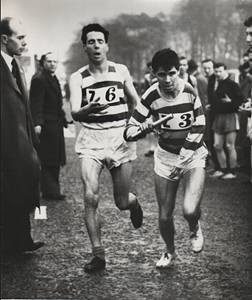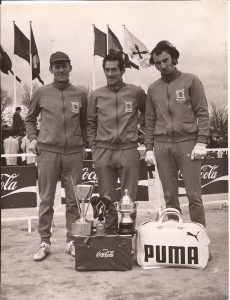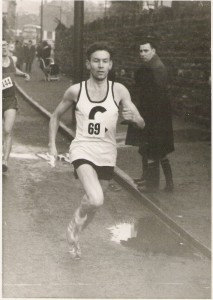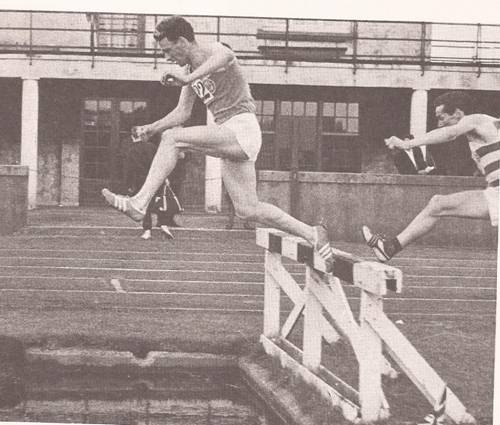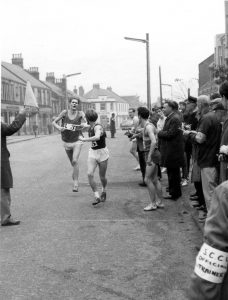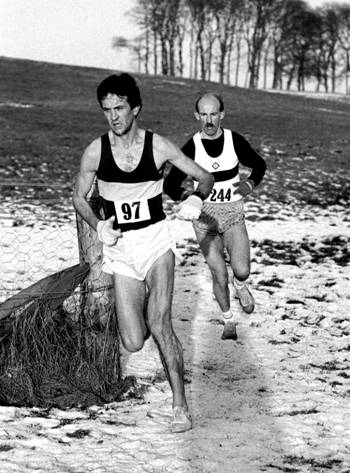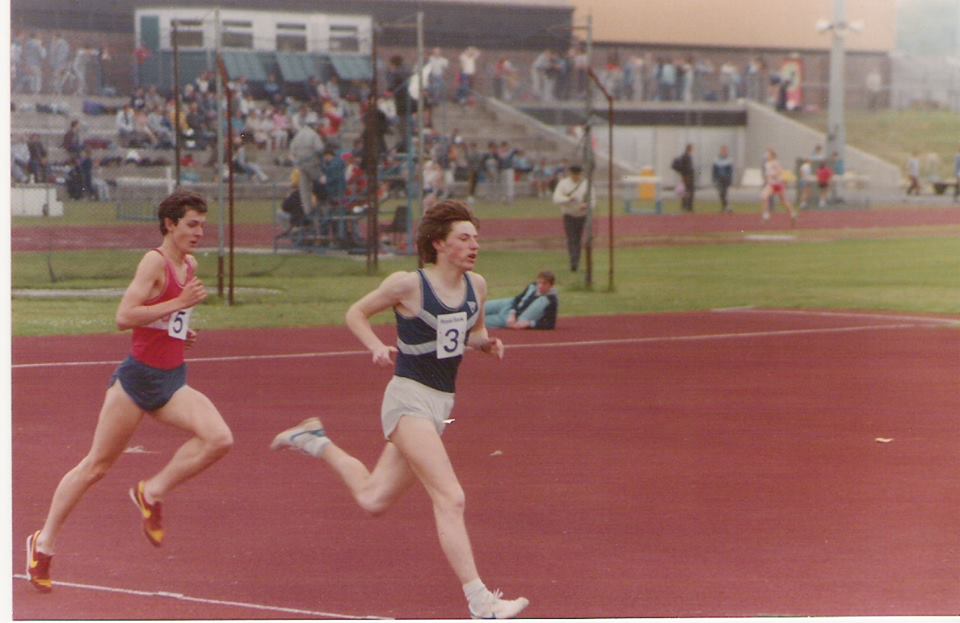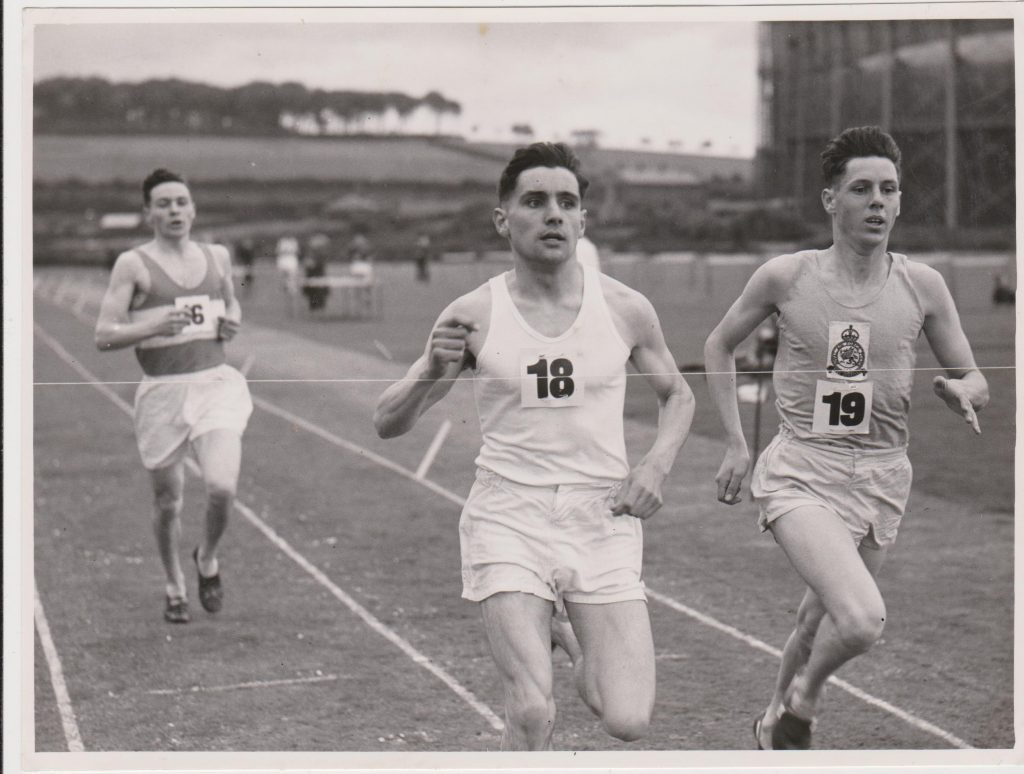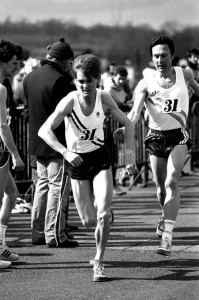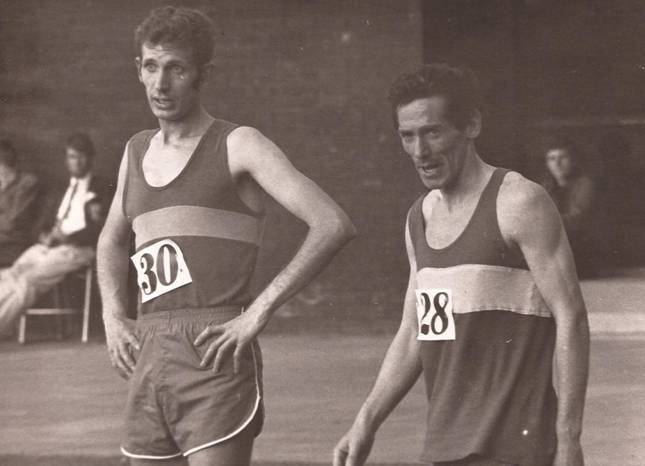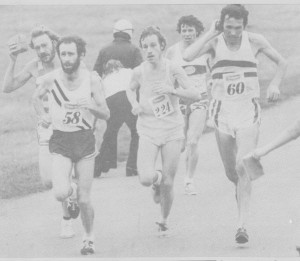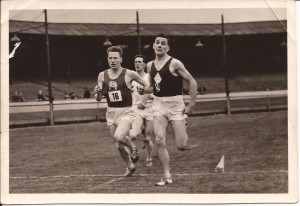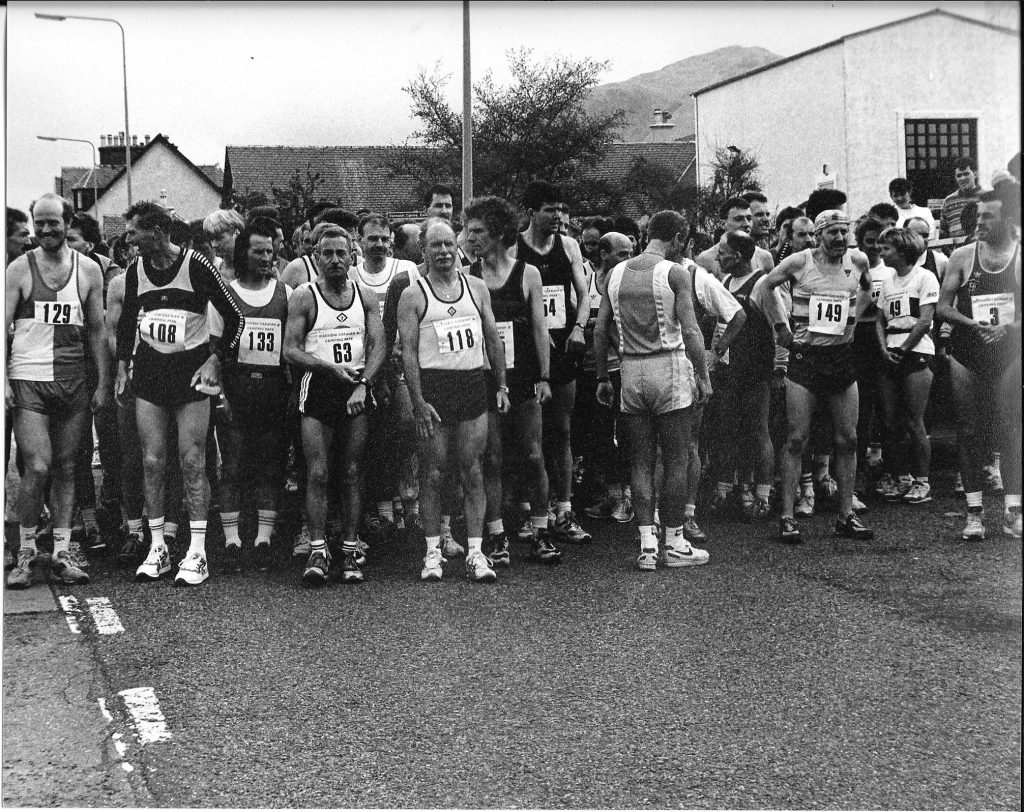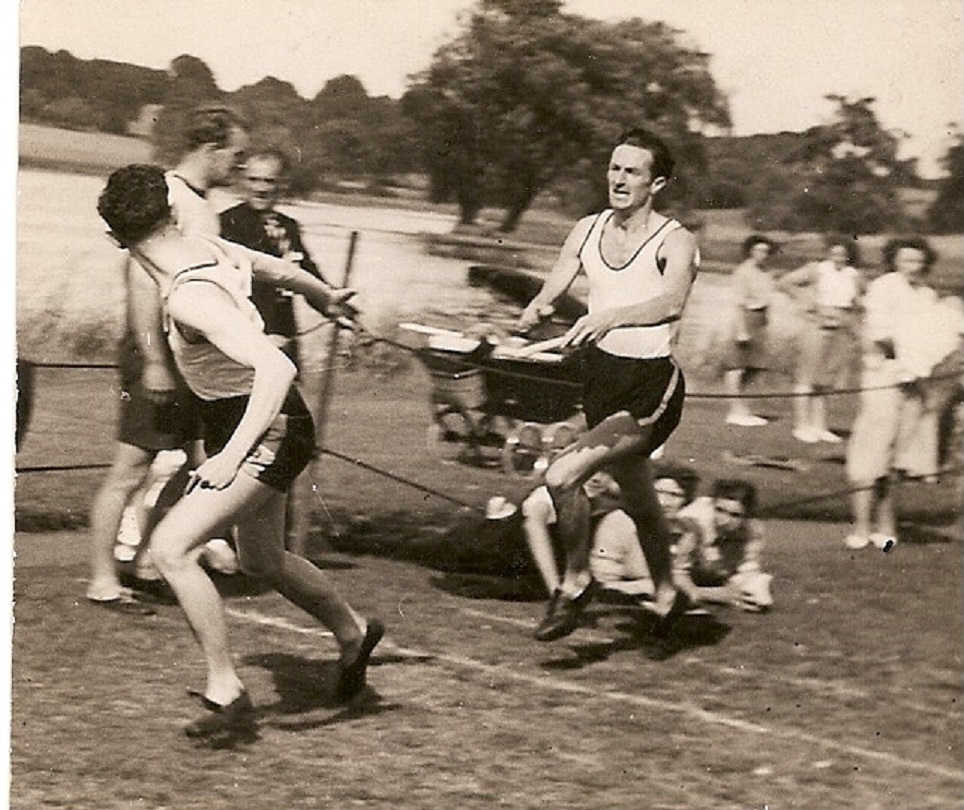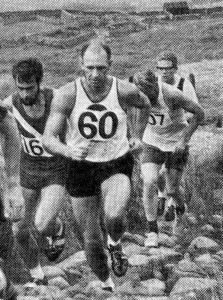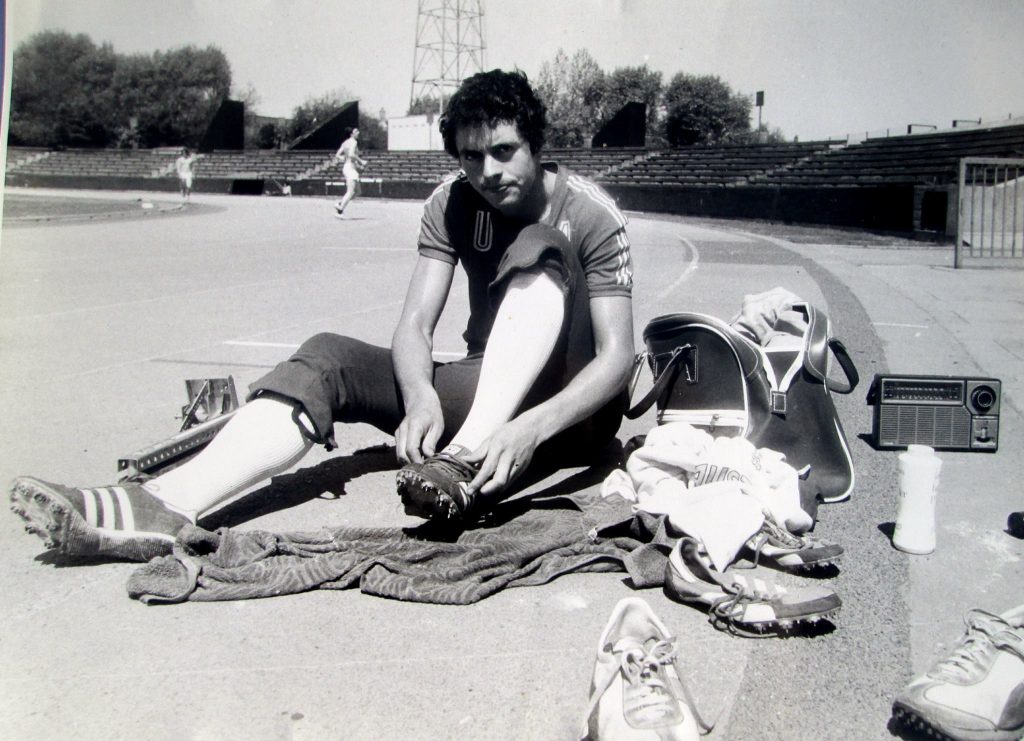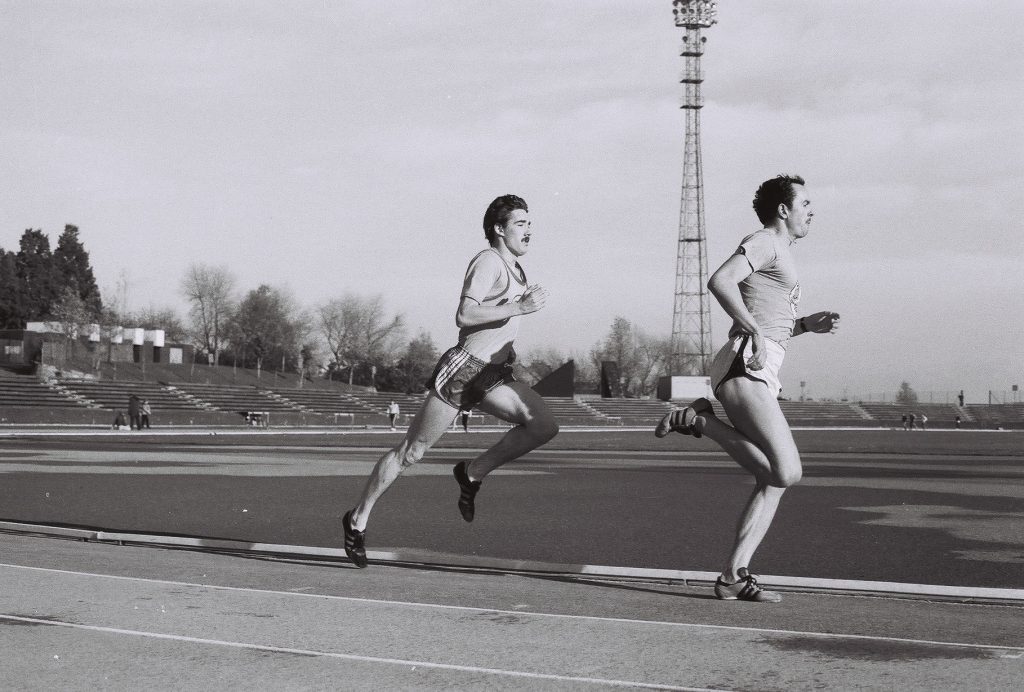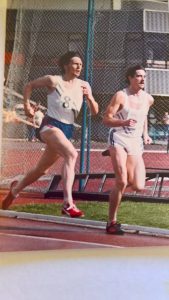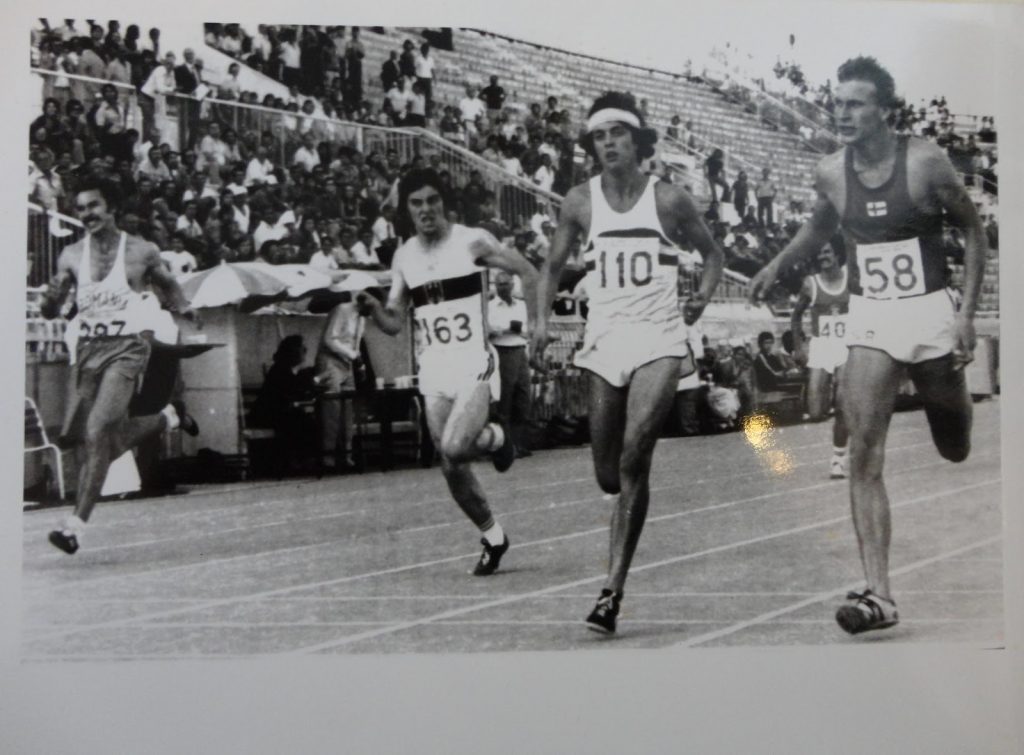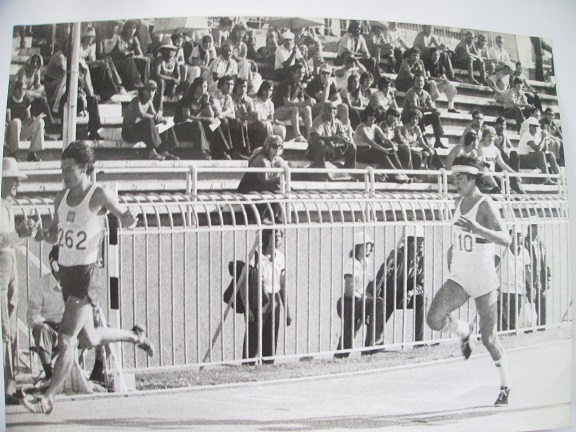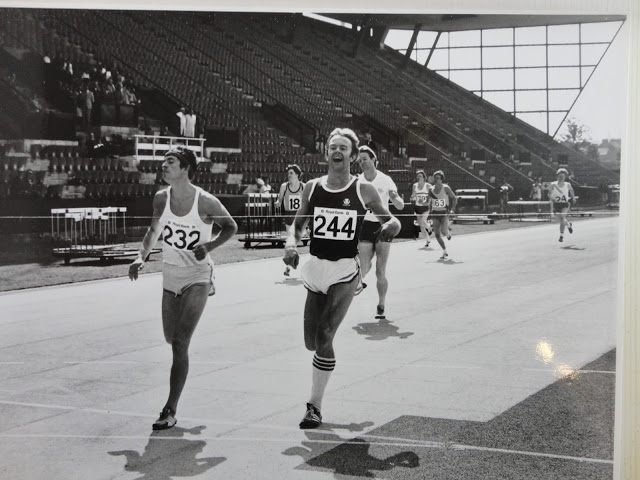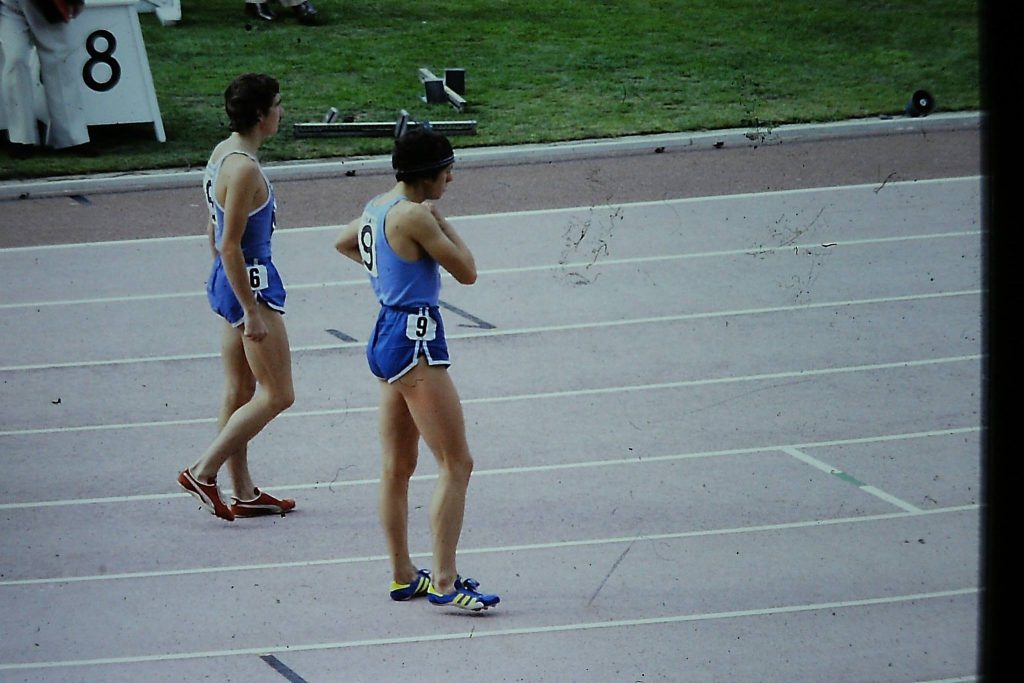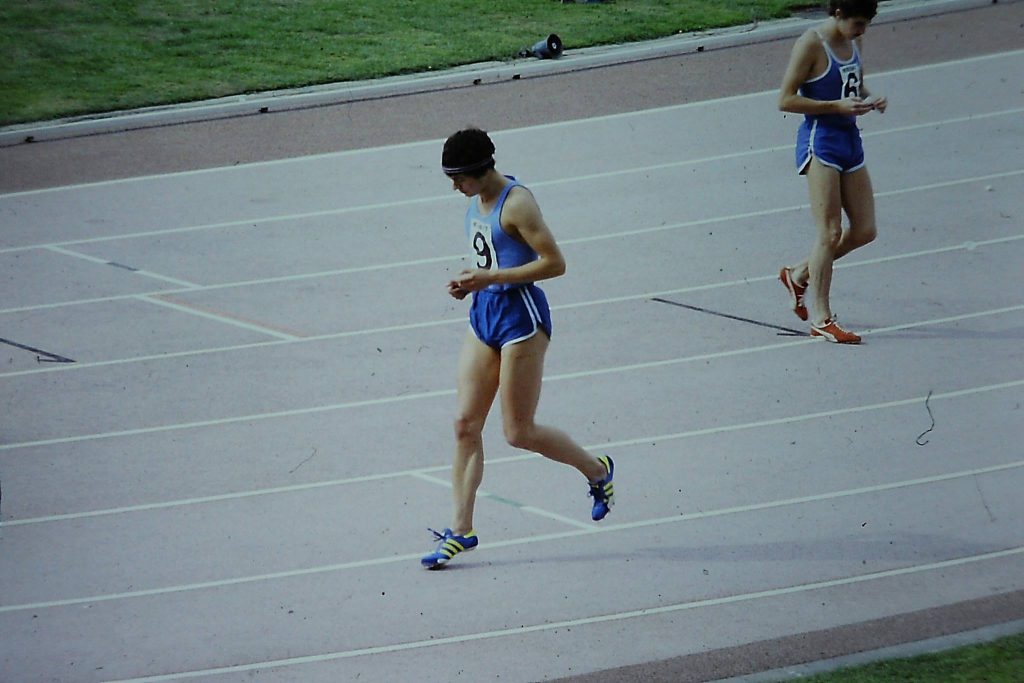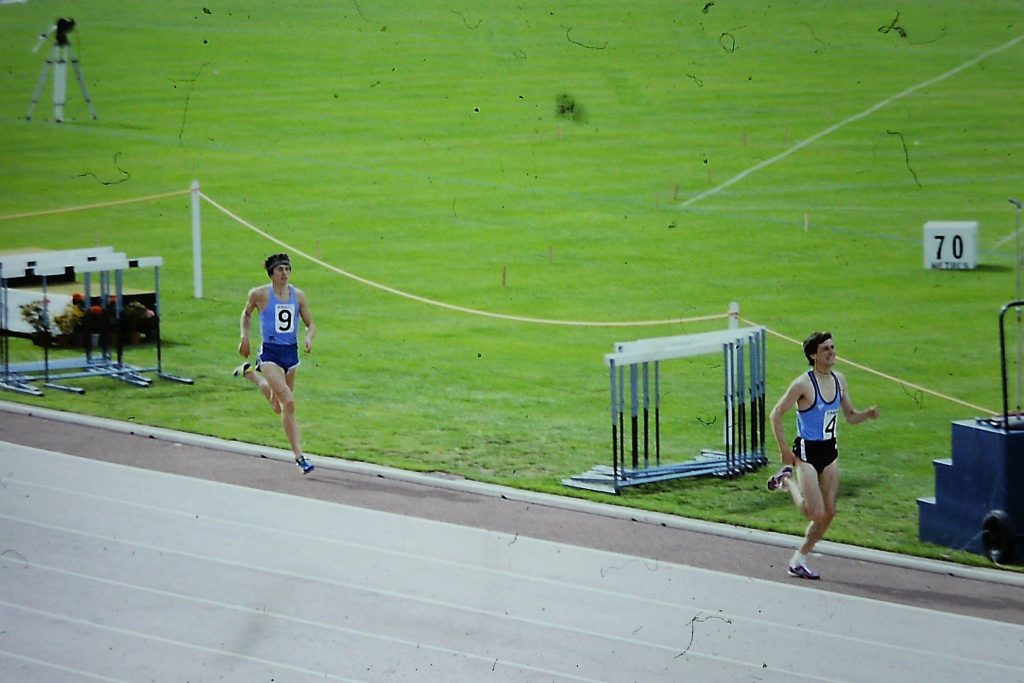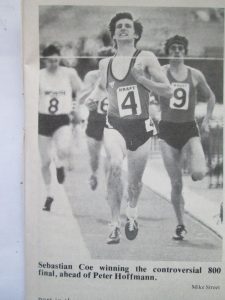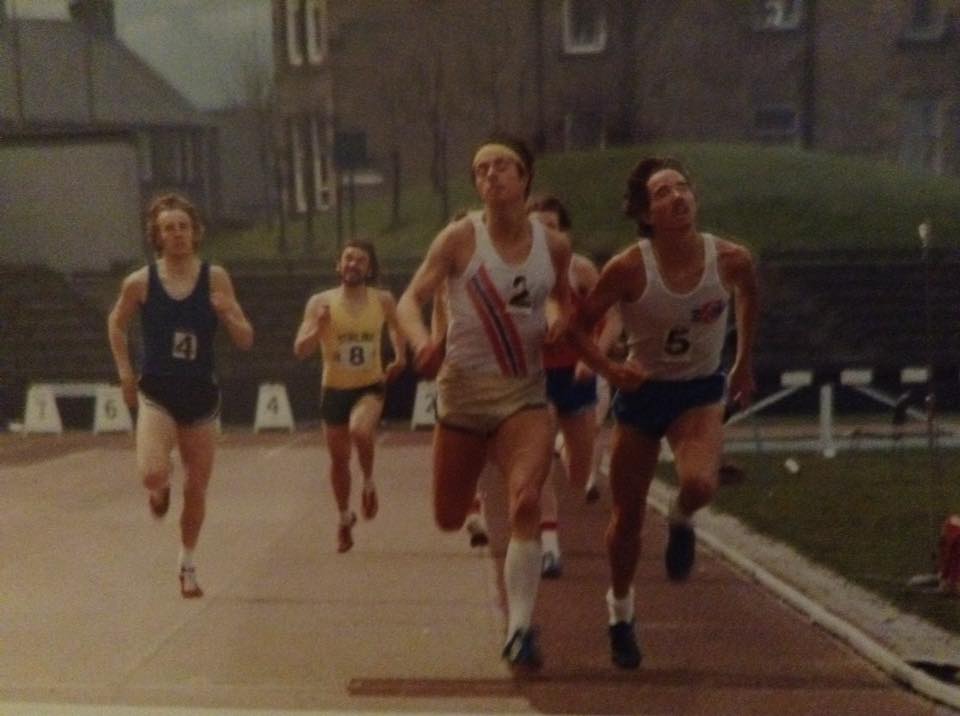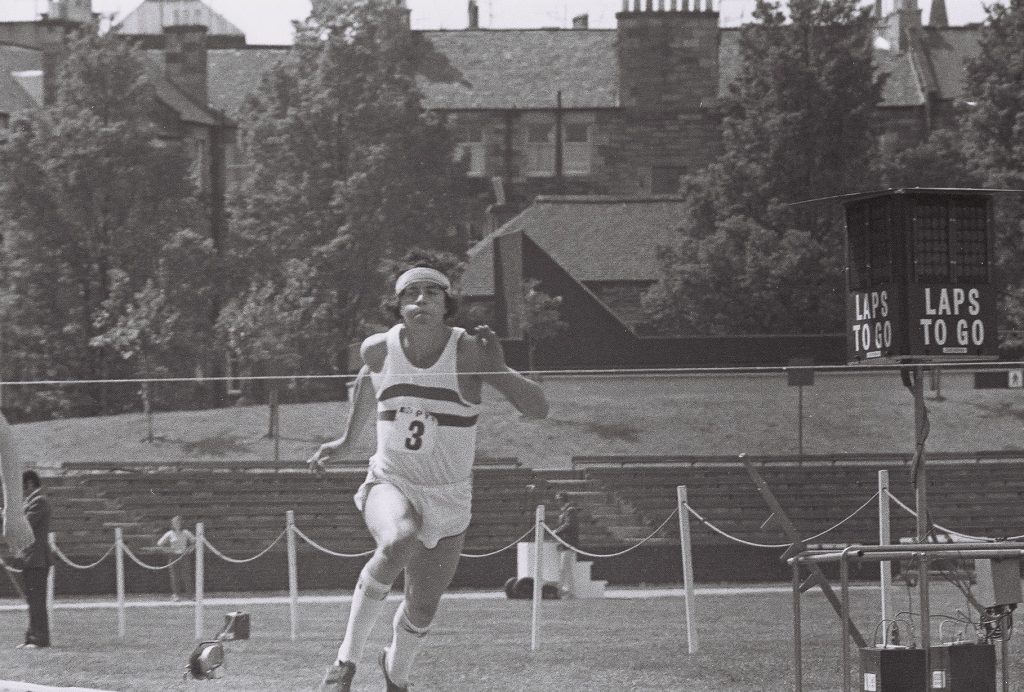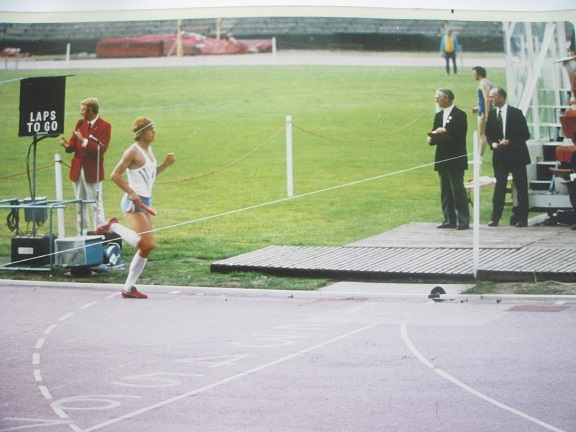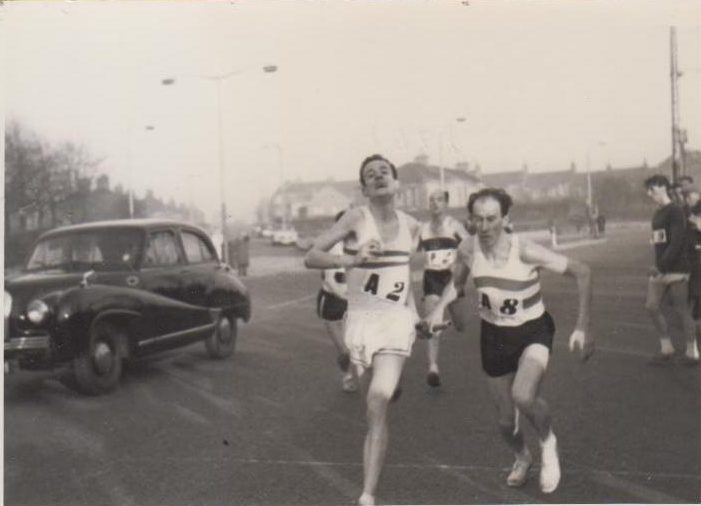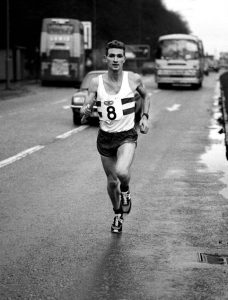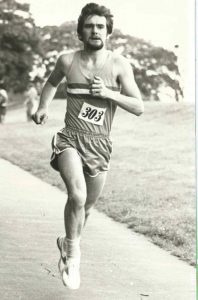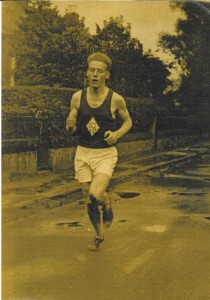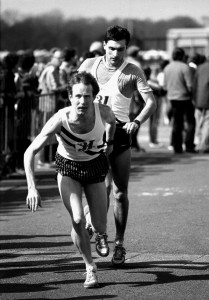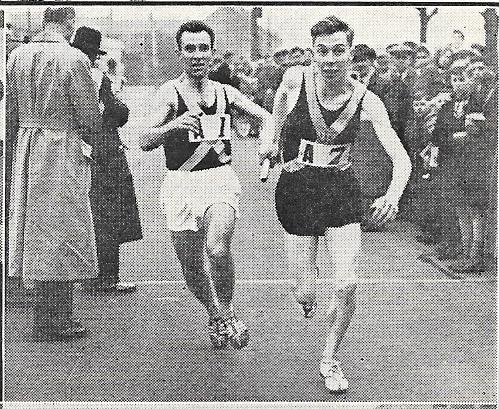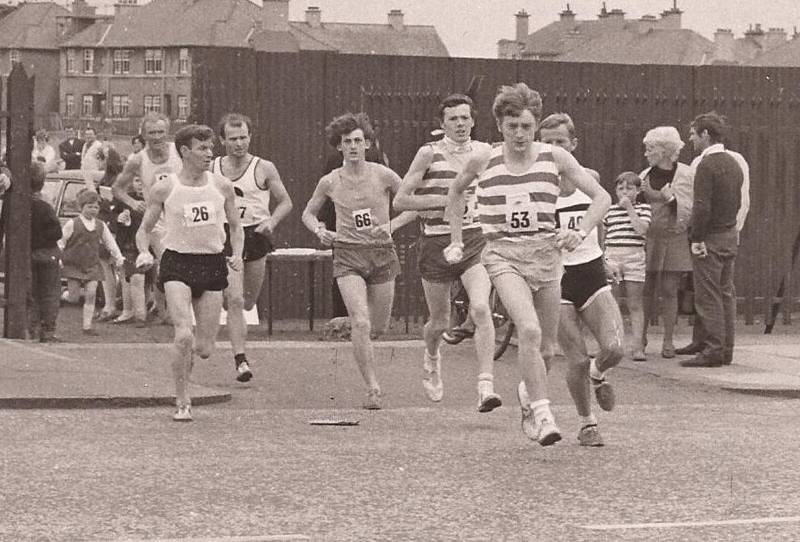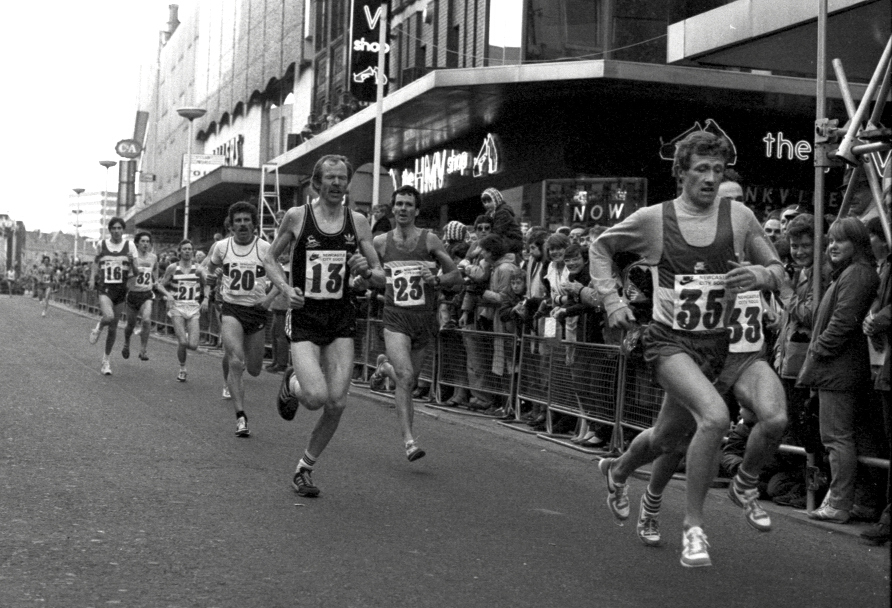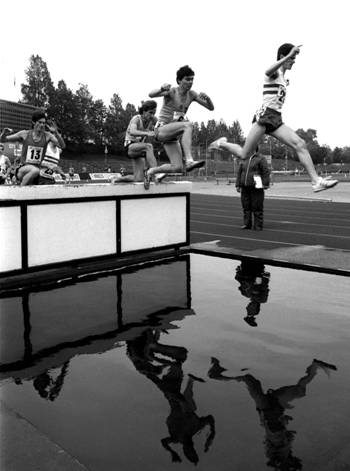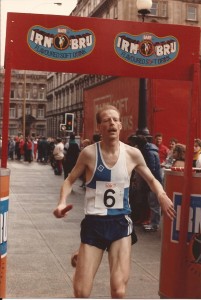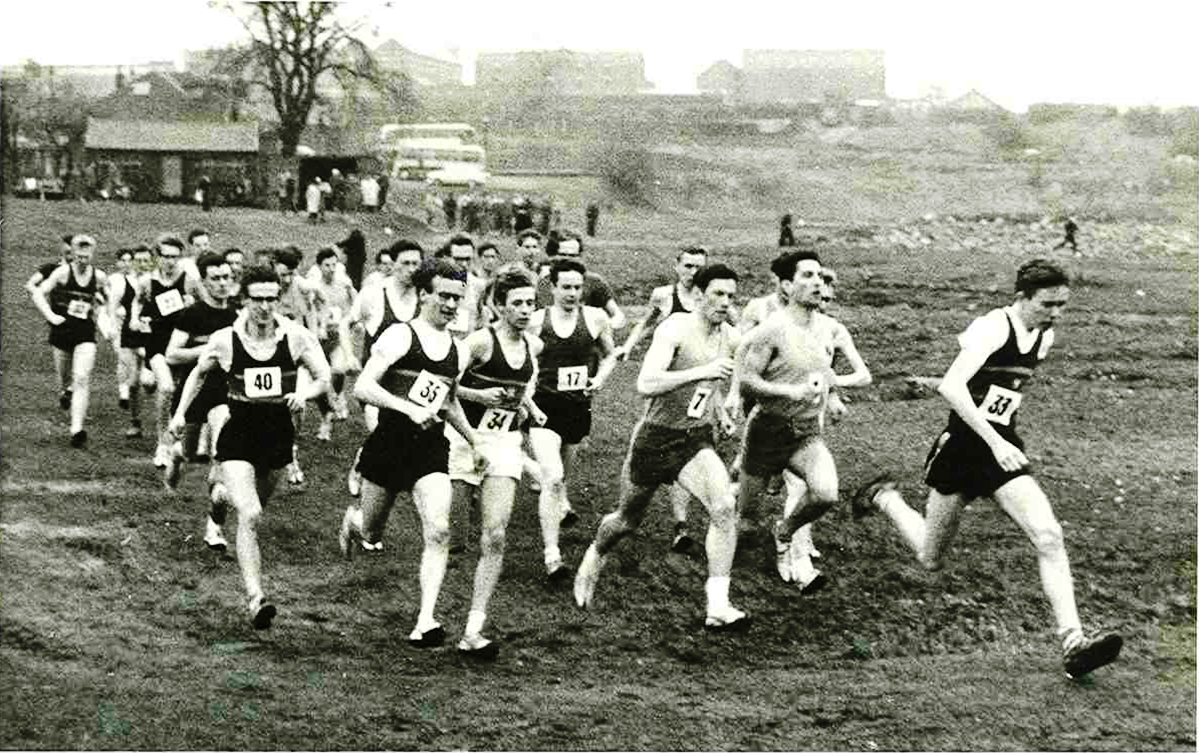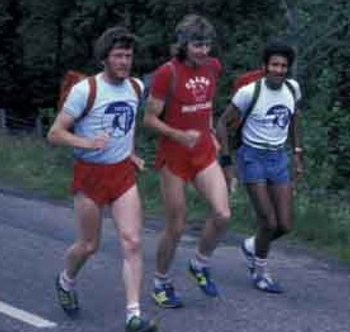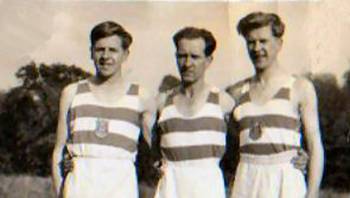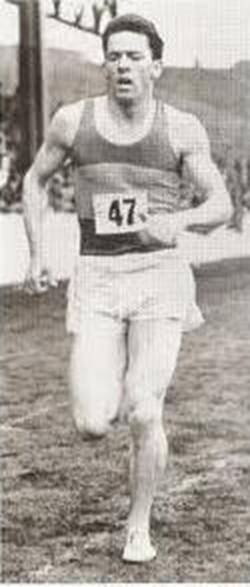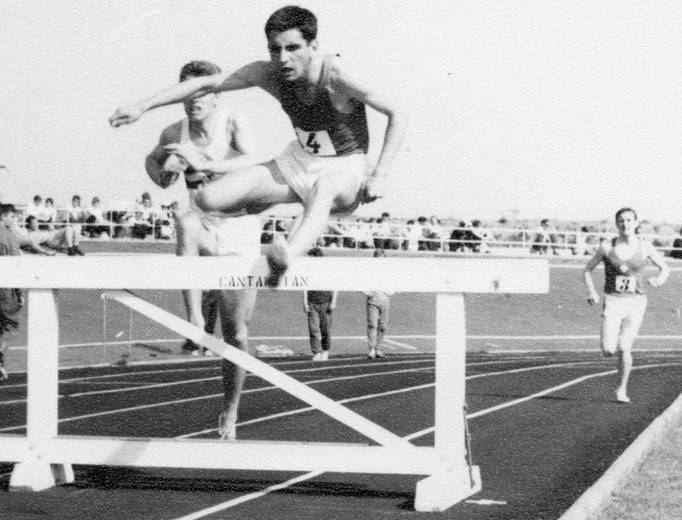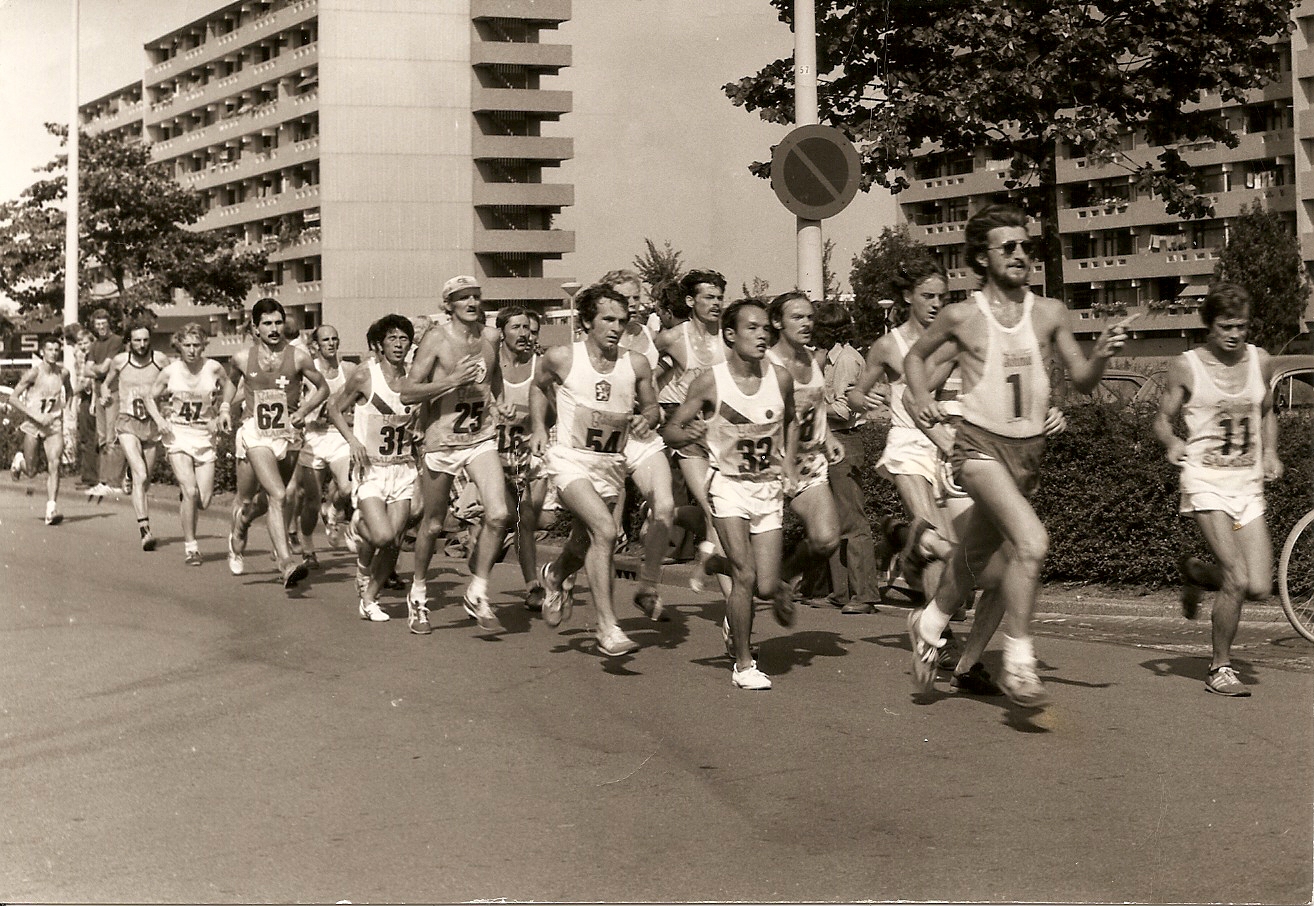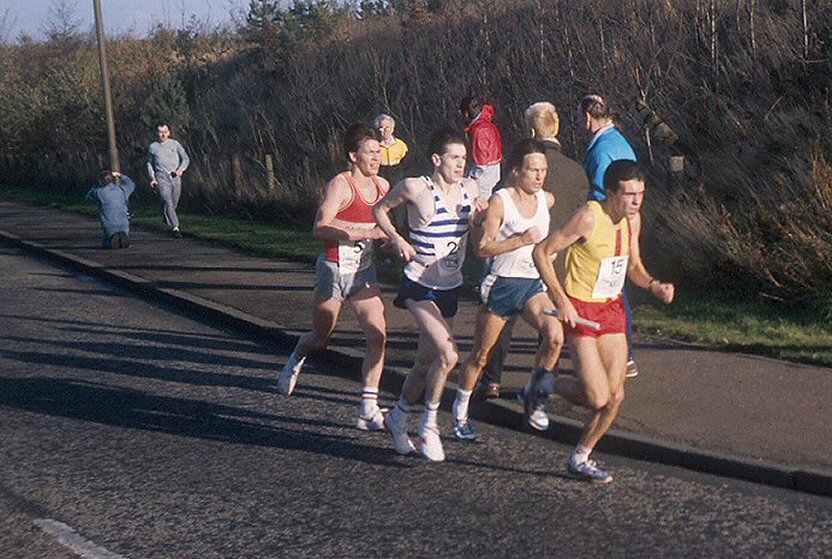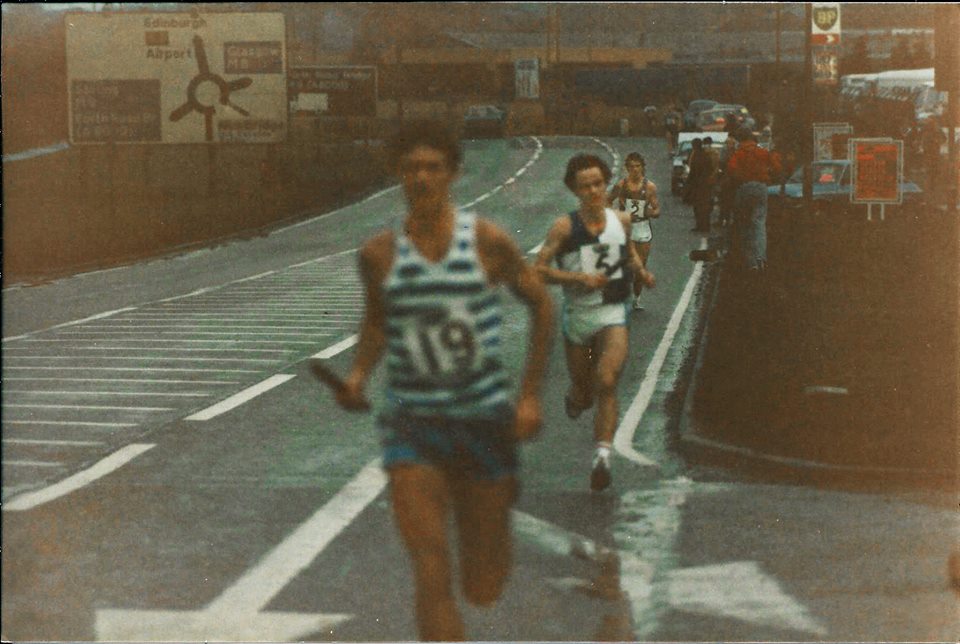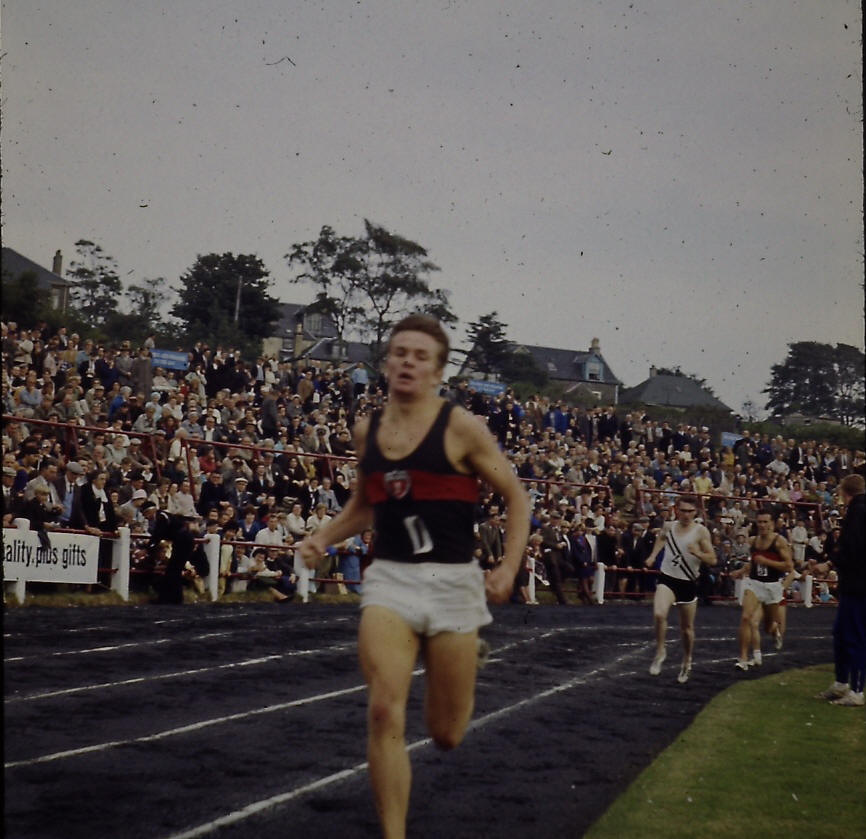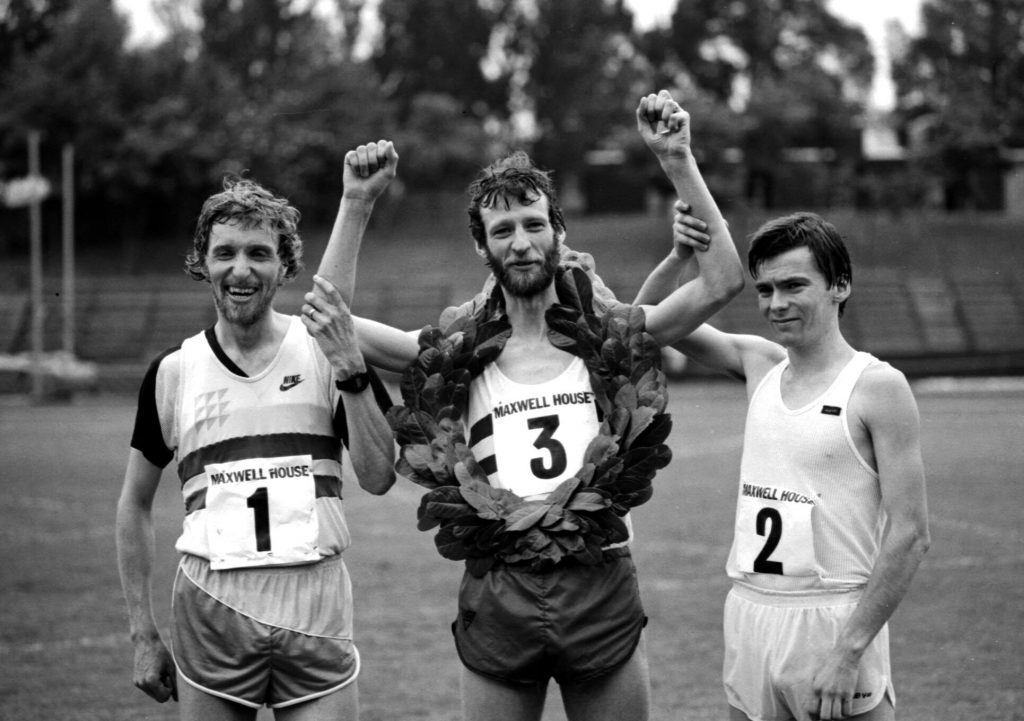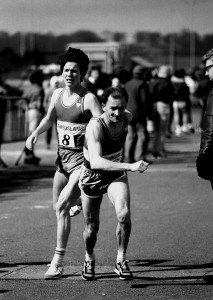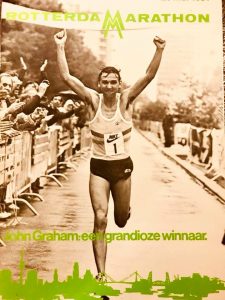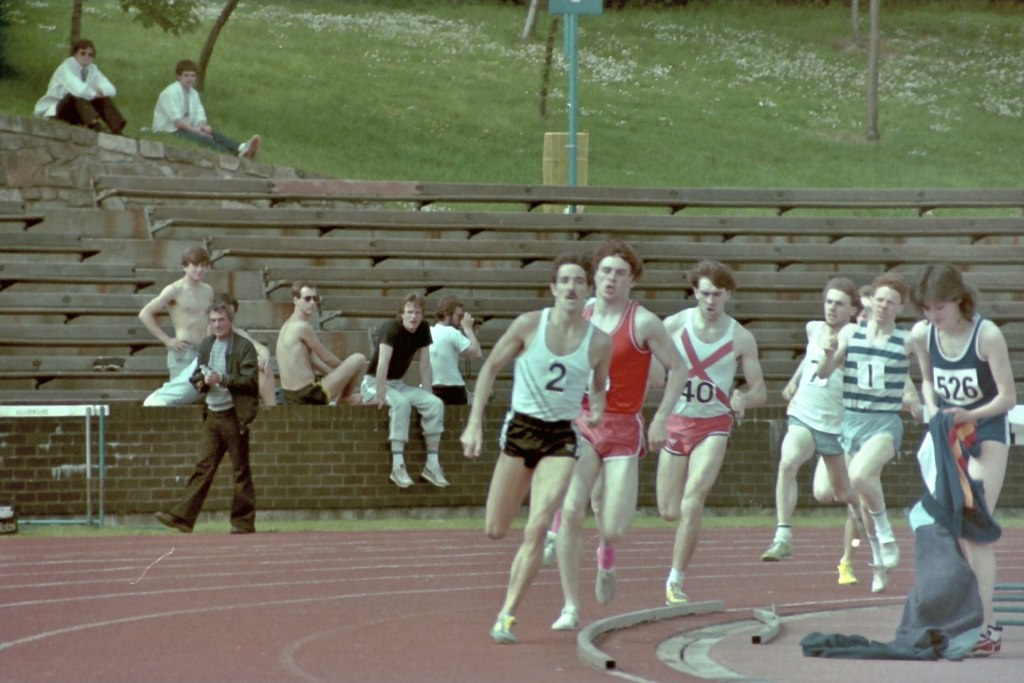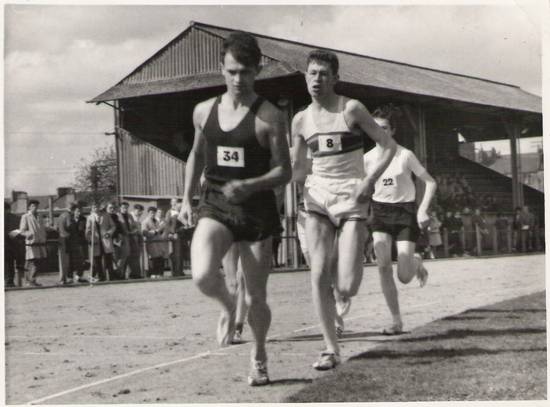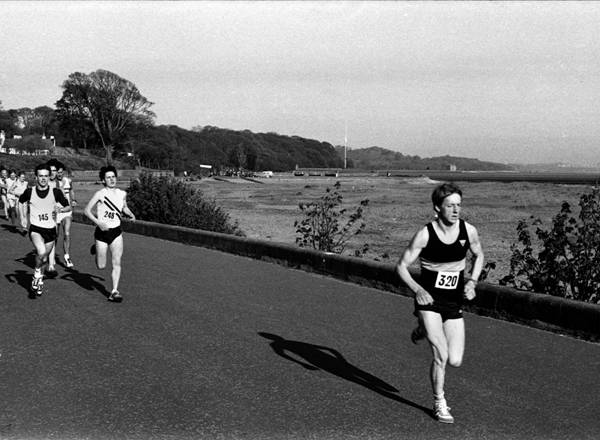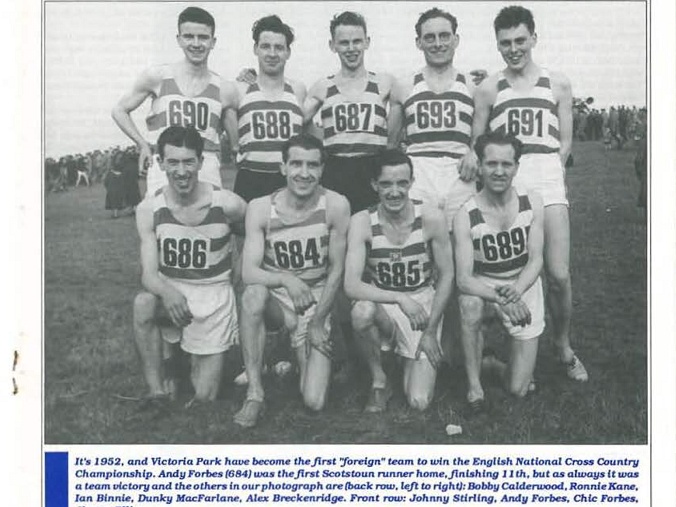Ronnie Kane (Z6) passing the baton to John McLaren in the Edinburgh to Glasgow Relay
Ronald S. KANE (1927-13.01.83) Victoria Park – SEE VP FAST PACK
1967 Mar 2.45.15
Ronnie was a Scottish cross-country international athlete, who was a key member of Victoria Park’s all-conquering squad in the 1950s. He contributed to four E to G team wins and was fastest on Stage 3 in 1953 (as he was in 1955). Then there were six team golds in the Senior National. Ronnie’s best individual position was 4th in 1954. He finished second in the 1952 Scottish Two Miles Steeplechase championship. In the 1960s and 1970s he became VP’s main distance running coach. In 1977, he became M50 Scottish Masters XC champion, after a close battle with Cyril O’Boyle.
Alasdair KEAN (5.11.47) Derby
1983 Mar 2.16.51
Alasdair appeared frequently in the annual Scottish marathon ranking lists between 1977 and 2004 and was in the top ten eight times. He finished fourth in the 1980 Scottish Marathon championship; and frequently, even as a veteran, ran fast in road races like Morpeth to Newcastle and Brampton to Carlisle He won age-group categories in the London Marathon – for example 2.32.15 in London 2000 is ranked ninth in the UK all-time list for over 50s. In 2003, aged 55, Alasdair could still run 2.36.18.
Brian KEARNEY, Lochaber AC
Brian won and held records for four major events – hill races at Goatfell, Cairngorm and Ben Nevis, and the 3 Peaks. He won the Ben Nevis Race three times – 1951, 1954 and 1957 – and twice broke the course record, as well as leading Lochaber to team titles in 1954, 1956 and 1957. That last year, after the race Brian was chatting to Olympic Steeplechase gold medallist Chris Brasher (who had presented the prizes), when a local fan approached and asked for an autograph – from Brian!
Phil KEARNS, Dundee Hawkhill Harriers
Phil ran the E to G six times between 1965 and 1971. He was a consistently good road and cross-country runner.
Jim KEENAN Springburn Harriers, Edinburgh AC
Jim was a good club runner who ran for Springburn in the Edinburgh to Glasgow in 1966, ’67 and ’68 and Edinburgh AC in 1971. He started out with the Glasgow club and ran for them in all the major championships, including the National where he was often a scoring runner, until 1970 when he moved to Edinburgh.
Pat KEENAN Victoria Park AAC
Pat was a solid club runner for Victoria Park who came between two magnificent generations of runners: when he started in the late 1950’s there were some of the great road running team still in action and two or three years later the all-round stars such as Hugh Barrow, Alastair Johnstone, Pat Maclagan and company were just getting into their stride. Nevertheless he did run in two Edinburgh to Glasgow relays and several cross-country championships. Several years later he came back and had a good career as a veteran: winning M50 individual silver in the 1986 Scottish Masters Cross-Country championship; and M60 team silver for Scotland in the 1993 British and Irish Masters (5 Nations) International Cross-Country.
JJ KEILT, St Modan’s AAC
Keilt was a very good clubman in that he raced in the club colours in all of the major road and cross-country relays and championships in the late 50’s and early 60’s.
Frank KIELTY, Clydesdale Harriers,
Frank was a good runner, mainly on the country and over the hills with many appearances in the Ben Nevis race to his credit, who competed in relays – Dunbartonshire, Midlands and West Districts – and championships including the Scottish CCU championships in the 50’s, 60’s and 70’s.
Colin KEIR Edinburgh AC
1978 3000S 9.44.0; 1982 5000 14.34.0
Colin was a hard-training, gutsy runner who had early success in cross-country and road as a schoolboy athlete and was part of a very good EAC Youth and Junior team, which won East District titles. In the E to G, which he contested six times, Colin moved into the lead on Stage 3 in 1977, en route to team silver, which EAC also secured in 1982.
Alexander ‘Sandy’ B. KEITH (23.01.46) Huntingdon, RAF, Aberdeen AAC, Edinburgh AC – SEE FULL PROFILE
5000m: 14.14.1 (1979); 10,000m: 30.29.4 (1959); Marathon: 2.16.12 (1975).
Sandy was an International Marathon runner for Scotland and for Great Britain. Amongst his clubmates he was feared and respected as an exceptionally tough man who trained horribly hard. He won two silver medals and one bronze in the Scottish Marathon championship; and with EAC won three E to G silver medals and, in the Senior National XC, two Scottish team titles in 1976 and 1978 (when he finished 11th).
Thomas KELLY Shettleston
In the 1956 E to G, Tommy was fastest on Stage 3 and Shettleston secured silver medals. In 1957 it was bronze and in 1958 silver again, with Tommy once more fastest on Stage 3. In the Senior National Cross-Country, he contributed to team bronze in 1958. As a veteran, Tommy won the Scottish Masters Cross-Country M60 title in 1984, when Shettleston won the team gold medals, as they had done in 1982 and 1983.
W.J. (BILL) KELLY, Cambuslang Harriers
Willie was a good runner who turned up at all club and championship races and ran in most road races (Gouroch HG, Strathallan HG) in company with club mates Andy Fleming and Gordon Eadie. He was seventh in the 1958 season-long Scottish Marathon Club championship which took in races at 12, 16, 20+ and the marathon itself. He finished a very respectable sixth in the 1962 Shettleston Marathon, in a time of 2.37.35. He ran the E to G four times; and was well up in the 1957 Ben Nevis race which was also supported by the SMC every year.
John KENNEDY Victoria Park 1989
1990 3000S 9.43.2
John had a brief but successful career: for VP in the E to G (running the prestigious Stage Six in 1990 and 1991, when the team finished sixth); and the Senior National; and as becoming the Scottish Veteran Harriers XC champion in 1991; when he also secured bronze in the Scottish M40 cross-country championships.
Stephen KENNEDY, Cambuslang Harriers
Stephen won two successive team gold medals in the 1983 and 1984 Scottish Junior National XC championships.
William KENNEDY Dundee Hawkhill
1963 6M 31.05.0
William ran for DHH in the 1963 E to G, when his team finished tenth.
Paul J. KENNEY (6.08.55) Dundee University, Leicester Coritanian AC, Fife AC, Blackpool & Fylde, Inverness Harriers, Middlesbrough – SEE FULL PROFILE
1500M: 3.56 (1974); 3000M: 8.31.6 (1974); 3000M Steeplechase: 9.07.6 (1975); 10,000m: 29.33.5 (1983); Marathon: 2.17.04 (1984).
Paul was a Scottish International cross-country runner as a Junior (a fine13th in the 1974 International) and a Senior (1976 and 1977). He was: 1976 East District Junior champion; won the Scottish Universities XC title in 1977 and 1979; and added the Northern District XC championship in 1983. Then he moved to England. He led Scotland to team victory in the 1985 Barcelona Marathon, finishing second in 2.18.34. Paul is the father of GB and Scottish track international athlete Laura Kenney/Whittle.
David KERR Garscube Harriers
A big heavily built man for a distance runner, David was a good half miler who went through all the distances up to the marathon where he won the Scottish Vets championships in 1981 in a time of 2:37:55.
Iain KERR Bellahouston Harriers
A good club runner who raced at all distances for his club including national championships. A competitor in most races, he was well known for his efforts in the Nigel Barge, GU Road Race, and other races.
Ian KERR (2.04.56) Ayrshire AC
5000m: 14.56.0 (1980); 10,000m: 30.30.42 (1981); Marathon 2.21.39 (1983).
Ian won the 1971 Scottish under-15 1500m title. For Ayrshire between 1976 and 1981, he ran the E to G six times in succession.
John M. KERR Airdrie Harriers – SEE FULL PROFILE
1960 6M 31.20.6; 1962 Mar 2.26.58.
John (or Johnny) was an ex-cyclist, strongly-built, with a low, powerful running style and a confident attitude. He became Scottish Marathon champion in 1961 and secured silver medals in 1960 and 1962. Tragically he died soon after, due to hypothermia caused by an accident at work.
John KERR Edinburgh SH, Edinburgh AC
31.48.4 (1973); 3000m Steeplechase: 9.14.0 (1975)
In 1974, John was part of the EAC team that won bronze medals in the Junior National XC. He ran the E to G in 1975, when EAC finished second. In 1976 he contributed to team bronze in the Scottish cross-country relay championships.
William KERR (11.07.1932-15.12.2000) Victoria Park, Anglo Scottish, Belgrave
One Mile: 4.11.8 (1962); 3000m: 8.05.4 (1963); 3M: 13.46.8 (1963) 6M: 29.42.4 (1963)
Bill won a bronze medal in the 1961 Scottish 3 Miles track championship. For VP, he ran the E to G seven times, including 1958 and 1959 (when they won team bronze medals) and 1961, when he was fastest on the prestigious Stage Six. In the Senior National XC, VP won silver in 1959; bronze in 1960 and1961; and another bronze in 1963, when Bill was first home for his team in a fine seventh place.
Alex KIDD Garscube Harriers
Alex won a silver medal in the 1956 Scottish Marathon championship. In the Senior National XC, his team won bronze medals in 1948; and his best individual position was 5th in 1951. Consequently, he represented Scotland in that year’s International XC championships. Alex ran the Edinburgh to Glasgow Road Relay 13 consecutive times, from May 1949 to November 1960. Like many of his generation, Alex had seen service in the middle east during the war and was on permanent medication for malaria.
Frank KIELTY, Clydesdale Harriers
Frank was a good runner who represented his club at all levels of competition – district, national and (once) in the Edinburgh to Glasgow over a period between the 1950’s and the 1980’s.
Ian A. KILPATRICK (27.03.52) Bracknell, Victoria Park
800m: 1.52.4 (1973); 1500m: 3.59.5 (1971); 3000m: 8.24.8 (1971); 3000m Steeplechase: 9.20 (1971)
Ian J. KILTIE (19.09.53) Edinburgh University, Ayrshire AC, Derby & County
1500m: 3.54.2 (1978); Marathon 2.23.51 (1981)
Ian was a sociable talented runner who, as his personal bests indicate, was a versatile athlete. For EU, he ran the E to G four times between 1972 and 1975; and once for Ayrshire in 1977. He was a respectable 34th in the 1979 Senior National XC; and much later became a veteran middle-distance runner.
George KING, Greenock Wellpark Harriers, Scottish Marathon Club
Between 1955 and 1965, George ran the E to G an impressive 11 times in succession. In the Scottish Marathon Championship he won bronze medals in 1954 and 1957. However his best marathon was in 1955, when he finished second in a fine 2.34.30, behind Empire Games champion Joe McGhee’s new Scottish record. George was third in that year’s international Edinburgh Highland Games marathon; and won a one hour race at the famous Ibrox Sports. George did well in the Edinburgh to Glasgow 45 miles ultra marathon. For several years, he was Captain of the Scottish Marathon Club.
David KIRK Dumbarton AAC
In 1979, he finished fourth in the Scottish Junior National XC, and consequently ran for Scotland in the Junior International Championships. He ran for Dumbarton in the 1978 E to G before emigrating to the USA. A specialist half miler.
Stuart G. KIRK (22.04.61-13.07.84) Tonbridge
1984 3000S 8.55
CR: Sco: 2 3000S ’82
Brian KIRKWOOD (20.09.52) Edinburgh AC, Racing Club Edinburgh – SEE FULL PROFILE
10,000M: 30.53.68 (1993)
Brian featured in the Scottish rankings between 1989 and 1994. Significantly, he was over 40 when he ran his fastest 10,000m. A former cyclist, he ran for EAC in the E to G seven times between 1981 and 1990, contributing to silver medals in 1982 and 1987, when he was fastest on Stage Three. In the Six Stage Relay, Brian was in EAC teams which won 1982 bronze, 1983 silver and 1984 gold. However, after he joined the semi-professional Racing Club in 1991, he secured bronze in the 1994 Scottish XC Relay; five golds and one silver in the Six Stage Relay; and seven gold medals in the E to G, including 1992, when he was fastest on Stage One. By then he had turned 40 and for the next ten years became one of the finest-ever veteran athletes in Scotland.
David KNIGHT (24.12.68) Perth Strathtay
3000m Steeplechase: 9.21.03 (1992); Marathon: 2.35.32 (2005).
David featured in the Scottish rankings between 1988 and 2007. He was a strong runner on track, cross-country and road.
Daniel S. KNOWLES (15.10.54) Edinburgh AC
Twin brother of Ronald.
800m: 1.56.0 (1976); 1500m: 3.46.5 (1978); One Mile: 4.08.86 (1976);
Danny was a Scottish International 1500m track athlete, who in 1976 won silver in the Scottish Indoors and bronze in the Outdoors; and in 1977 improved his outdoor medal to silver. For EAC, he contributed to team bronze in the 1974 Junior National XC and the 1977 Senior National XC; and in the E to G, silver medals in 1973, 1975 (when he was fastest on Stage Seven) and 1976 (again fastest on Stage Seven). In the Scottish XC Relay, it was bronze in 1976 and silver in 1977.
Ronald S. KNOWLES (15.10.54, d.2000) Edinburgh AC
Twin brother of Daniel.
800m: 1.54.7 (1974); 1500m: 3.48.2 (1975); 8.29.81 (1981); Marathon: 2.34.59 (1982)
Ronnie was a Scottish International 1500m athlete, who was third in the 1974 Scottish Indoor championship; and third in the 1977 Outdoor Track. For EAC, in the Scottish XC Relay, he secured bronze in 1976 and silver in 1977. He added silver in the 1981 Six Stage Relay. Team bronze medals were won in the 1974 Junior National XC and the 1977 Senior National XC. In the E to G, Ronnie contributed to three silver medals, in 1973, 1975 and 1976, when he was fastest on Stage Eight.
Edward KNOX (9.05.47) Springburn Harriers – SEE FULL PROFILE
One Mile: 4.15.1 (1967); 3M: 13.48.4 (1966); 10,000m: 30.42.6 (1972)
Eddie was an immensely talented athlete, especially as a Junior. He did win a bronze medal in the 1967 Scottish Three Miles championship. However, this was dwarfed by his success in the Scottish Junior XC championship (1966 second; 1967 first; 1968 second); and the Junior International XC (1965 5th, 1966 3rd, 1967 a fantastic victory). Springburn won Scottish Junior XC team silver medals in 1966 and 1968. After Eddie started working, he found that his training suffered, although he finished a good tenth in the 1972 Senior National XC. He ran the E to G for Springburn in 1965, 1966, 1968, 1969, 1970, 1971 (when they finished fourth), 1972, 1973 and 1974.
Bill Stoddart, Lachie Stewart and Eddie Knox
Calum LAING (1936- ) Glasgow University, Victoria Park, Inverness, Ross-shire SC – SEE PROFILE IN FAST TRACK GU
3M Internat XC
One Mile: 4.15.3 (1962); 3M: 14.01.6 (1962;) 6M: 29.53.8 (1962).
Calum was a very talented and successful young athlete who ran for Scotland on track (3 Miles) and country (Senior International championships in 1962 and 1963). In 1962 he: finished third in the Senior National XC; won the Scottish 6 Mile title and was third in the 3 Miles.
Graham C. LAING (1.11.56) Aberdeen AAC, Inverness Harriers – SEE FULL PROFILE
3000m: 8.18.80 (1982); 5000m: 14.20.50 (1981); 10,000m: 29.22.0 (1983); Marathon: 2.13.59 (1981).
Graham was an immensely talented natural athlete who represented Scotland at 10,000m; and at Marathon (which he contested in the 1982 Commonwealth Games, finishing a very good 7th). In 1979 he won the Scottish 10,000m title; and in 1980 the Scottish Marathon. For Aberdeen AAC, he was an invaluable part of teams which won: the 1976 Scottish Junior National title; and three Edinburgh to Glasgow Road Relays in 1983, 1986 and 1988; and also smashed the John o’Groats to Land’s End Relay record in 1982.
J. Stephen LAING (22.10.57) Gala, Edinburgh AC
800m: 1.50.7 (1979); 1500m: 3.49.79 (1980); 3000m Steeplechase: 9.42.6 (1992).
Steve was a Scottish International track athlete at 800m and 4x400m Relay, who also won a vest for Great Britain. He won a bronze medal in the 1980 Scottish 1500m championship. For EAC, he ran the E to G in 1983 (when they finished fourth) and 1985; and in 1982 contributed to team bronze in the Scottish Six Stage Road Relay championship.
Thomas W LAMB Bellahouston Harriers
Tommy was a Scottish International Cross-Country runner who did well for the team in the 1938 International XC championships, finishing a good 32nd. He was a successful athlete before and after WW2. In the Senior National XC, Bellahouston finished: third team in 1936; third again in 1938 (when Tommy was fourth); and first in 1939. They regained the team title in 1947; and finished second in 1949. In the E to G, it was gold in 1936 and 1938, silver in 1939 and bronze in 1937 (when Tommy was fastest on Stage 1). In the Scottish Two Miles Steeplechase championships, he won gold in 1946 and 1947 and bronze in 1950. Back in 1939 he had secured a silver medal in the Scottish 3 Miles championship.
George LAMONT Victoria Park
George was a Scottish International 3 Miles track athlete in 1947. That year he had finished fifth in the Senior National XC championship (when VP won team silver medals) and was unlucky not to gain selection for the International XC championships. George won two silver medals in the Scottish One Mile championship – in 1946 and 1947.
John W. LAMONT (13.12.56) Aberdeen AAC, Shaftesbury H
1983 Mar 2.23.07
John was a popular, hard-training athlete who became a close friend of world-famous runners Dave Bedford and Don Ritchie. In the E to G, his AAAC team finished 8th in 1979 (and won the ‘most improved’ medals) and 8th again in 1980. In the 1983 Senior National, John contributed to team bronze. He was fourth in the 1982 Scottish Marathon championship.
David B. LANG (15.11.50) Glasgow Police, Shettleston, Aberdeen, Fife, Elgin, Cambuslang
5000m: 14.31.7 (1979); 10,000m: 30.58.2 (1979); Marathon: 2.22.19 (1978).
Davie was a tough athlete who ran for three different clubs in the E to G: Shettleston (including victory in 1976); Aberdeen (third in 1981); and Cambuslang (1982; and 1986, when the team won silver medals). In 1981 he became Northern District cross-country champion. In the Junior National XC, Shettleston won team silver in 1970 (when Davie was 10th) and gold in 1971. In the Senior National XC, Shettleston won team bronze in 1976; and gold in 1977, when he was 15th.
Danny LAPSLEY (Irvine YMCA, West Kilbride, Beith Harriers)
Danny was a good strong running athlete who won South Western District Youths championship in 1951 (Irvine) and 1952 (West Kilbride), and was third in SCCU championships in 1950/51. Failing to finish the national the following year, he was eighth in the junior race in both 1953 and 1954, fourteenth in 1955. Danny started as a member of the short lived but successful West Kilbride AAC in Ayrshire before moving to Beith Harriers in search of more competition. Very successful at District level, he ran well at national championships but with only the one medal to show for it.
Andrew LAW Greenock Glenpark Harriers, RAF, Aberdeen AAC
Marathon: 2.25.31 (1979)
Andy started out with Glenpark before joining the RAF and was ranked as a marathon runner.. He ran the E to G for both clubs including for AAAC in 1974, when they finished seventh.
Hamilton LAWRENCE Teviotdale Harriers
At the end of June, 1954, he won a silver medal in the 1954 Scottish 6 Miles track championship, well behind the record-breaking Ian Binnie, but in front of fine athletes like Harry Fenion (Bellahouston) and Charlie Fraser (ESH). Earlier that year, Hamilton had finished a decent 20th in the Senior National Cross-Country, but his strength lay in road running, at distances between ten and 15 miles – unfortunately ‘half-marathons’ would not be invented for another 30 years. At the end of May in the Scottish Marathon championship, Hamilton was sharing the lead at 15 miles with Joe McGhee who was to break the Scottish record in that race and, famously, go on to win the Empire Games Marathon title. The Teviotdale man stopped once McGhee broke away but recovered well enough to secure his 6 Mile medal. At the end of the season, In ‘The Scots Athlete’ Emmet Farrell reported “Lawrence maintained a very high standard, winning all his road races except the marathon. If McGhee had raced against him in these ‘semi-marathons’ he might have been hard pushed to beat the Border speedster.”
Bill LAWRENCE, Forres Harriers
He won the 1958 Cairngorm Hill Race 1958; and in 1959 was tenth in Ben Nevis and third in Goatfell. His best position in Ben Nevis was seventh in 1959, one place in front of future marathon champion Ron Hill. In 1959 he became North of Scotland Cross-Country champion.
Keith LAWRIE (Stranraer Harriers, Ailsa AAC, Ayr Seaforth AAC)
Keith was a tough man who worked with the Forestry Commission and this hardness showed in his running. A talented athlete, 1965 South Western District junior champion after finishing third behind Tommy Cochrane and Ian Harris. Keith ran well on all surfaces but had an unfortunately short career – maybe because of work commitments but he also lived in Newton Stewart where opportunities for competition plus travelling difficulties possibly contributed.
Alan LAWSON
Dundee man Alan has been a lifelong runner but in the main it was recreational rather than club-based racing oriented. He did, and does, however contribute greatly to the sport. Initially he was the epitome of the casual runner, despite having won the school mile in his final year: he did not join a club but nevertheless ran a lot – unobserved, untimed, unnoticed. His running around Edinburgh in the late 70’s inspired the concept of the 7 Hills race, the first running of which was in 1980. In the 1980’s with the running boom in full swing, he ran several marathons including the famous Dundee snowstorm marathon. Once the half marathon was invented, he ran several of those. His standards were sub 3 hours for the marathon and about 1:20 for the half marathon. He ran in the Scottish Vets in the Home Countries International several times and in 2004 ran the West Highland Way race and placed fifth in approximately 20:30. He also ran the London Marathon – again inside 3 hours. Alan has also run the Speyside Way and the Lairig Ghru and likes to take part in ‘novelty’ events such as the Black Rock race in Fife and has done the Southside Six in Glasgow (Six parks, 16 miles). 2018 will be the 39th running of the Seven Hills and Alan will still be in charge.
Alan has also been a member of Dundee Hawkhll Harriers and Dundee Road runners.
Alistair LAWSON Dumbarton AAC
1970 Mar 2.43:34
Alistair was a tough runner who relished arduous off-road events, despite tackling the E to G four times between 1972 and 1976. A Loughborough graduate he was an ‘outdoors man’ par excellence – walking and climbing were also passions of his but as a member of Dumbarton AAC with Colin Martin, Allan Adams, Billy Cairns and company in the 60’s and 70’s he ran in all the major championships. As a veteran he contributed to team silver in the 1988 Scottish Masters XC championships. With team mate Mike Lidwell he devised the original Glasgow-Ft William relay which started in George Square at 6:00 am and predated the West Highland Way by several years. The routes were largely similar but not at all identical. Alistair is the older brother of Alan.
Jim LAWSON Springburn Harriers
Jim was a very able distance athlete who came up through the ranks from Junior Boy to Senior Man – a journey not completed by many. As a Junior Boy in 1969/70 he was ninth, as a Senior Boy in 1970/71 he finished second to Mark Watt of Shettleston and one place ahead of Jim Thomson of Law, in 1971/72 he was first in the Youths race, the following year he was sixth, in ’73/’74 as a first year junior he was thirteenth and part of the winning team. He also ran in the Edinburgh to Glasgow relay with his first run being in 1973 on the last stage andin ’74 he was on four. Jim disappeared from the scene at that point plagued by injury
Christopher LECK Spango Valley AC
Chris was a valuable team man for Spango, contributing to medal-winning successes in all three major winter relays. In the Scottish cross-country relay, Spango finished third in 1983 and second in 1986. The E to G (which Chris ran eight times in succession between 1980 and 1987) added ‘most improved’ awards for 7th place in 1981; and bronze in 1984. The Scottish Six-Stage Road Relay produced three bronze medals in 1983, 1985 and 1986.
Bobby and Billy LEES Victoria Park
Billy LEES Victoria Park
Billy ran for Victoria Park for three or four years in the early 1960’s turning out for them in the District and National Championships and Edinburgh to Glasgow Relay, brother of Bobby
Ian LEGGETT Clydesdale Harriers, Livingston AAC and Lothian Runners – See complete profile
1970 10,000m: 31.15.0.
Ian was an irrepressibly cheerful runner who started as a senior man after being a good football player, and was still running for Scottish Masters in the M75 age group. Ian ran track, road and cross-country with commendable results – eg fourth in Midland District championships, second in Inter Counties Cross country behind John Linaker – and several road race victories.
Ian Leggett finishing the traditional Nigel Barge race
Derek F. LEITCH (30.12.52) Strathclyde Univ, Garscube, Larkhall YMCA
800m: 1.50.8 (1978); 1500m: 3.50.4 (1978)
Derek was a Scottish International track athlete at 800m and 1500m. In the Scottish 800m championships, he won silver in 1976 and bronze in 1978. Much later he had considerable success in Scottish veteran middle-distance championships.
Walter LENNIE Vale of Leven AC, COLCHESTER HARRIERS SEE VALE OF LEVEN FAST PACK
Walter was a Scottish International track athlete, specialising in One Mile races. He won the Scottish title in 1951, having secured a silver medal in 1949. In 1950 he became the Midland District XC champion; and also finished second in that year’s Junior National XC.
Christopher LENNOX Glasgow University, Springburn Harriers
3000m Steeplechase: 9.48.0 (1972).
Chris was a hard-training cross-country runner who represented Scottish Universities. He ran in the E to G for GU and Springburn. In the 1972 Senior National XC he finished 28th and was first home for GU.
John H. LINAKER (16.11.39) Pitreavie AC, Motherwell YMCA Harriers – see full profile
One Mile: 4.09.5 (1966); 3M: 13.40.6 (1966); 3000m Steeplechase: 8.41.6 (1966); 6M: 28.17.2 (1968); Marathon: 2.21.19 (1968).
John was an extremely tough, confident, charismatic athlete who ran for Scotland on track (2 Miles, 3 Miles, Steeplechase) and country. He won the Scottish Steeplechase title six times and broke the Scottish All-comers’ record; as well as being Senior National XC champion and featuring in winning E to G and Senior National XC teams. As a veteran athlete, for many years he ran very fast on track, road and country. Perhaps his best-ever performance was in the 1966 Commonwealth Games in Kingston, Jamaica, when he finished 7th with a brilliant 8 minutes 41.6.
John Lineker leadingLachie Stewart over the water jump
Mike LINDSAY, Carnethy Hill Runners
Mike won the Ben Nevis Race in 1987. He ran for Scotland in the very first World Mountain Running Trophy in 1985.
Robert LINDSAY (9.07.59) Edinburgh Southern
1.51.21 (1984); 3.48.5 (1984); One Mile: 4.07.75 (1984); 5000m: 14.22.0 (1986).
WF LINDSAY Gala Harriers
He ran for Scotland in the 1955 International XC championships, having finished 8th in that year’s Senior National XC.
William LINTON Braidburn AAC, Clydesdale Harriers
Bill was a talented short middle distance runner with Braidburn AC and team mate of several good athletes such as Neil Donachie. While with them he won a silver medal in the 1953 Scottish 880 yards championship; and also ran the E to G that year. After moving to Cardross, he joined Clydesdale Harriers and became part of very successful relay teams over 4 x 440y and the medley distance (880, 220, 220 and 440), one of which won the SAAA 4 x 440 y championship in 1955.
Keith LOGAN (13.07.66) Lothian, Teviotdale – SEE FAST PACK TEVIOTDALE
800m: 1.53.0 (1989); 1500 3.56.2 (1991).
Keith was a Scottish International athlete at 800m. He won a bronze medal in the 1990 Scottish Indoor 800m championship. For Teviotdale, he ran the E to G five times, being fastest on Stage One in 1989 and winning team bronze in 1991. In the Senior National XC, Teviotdale won silver medals in 1989; and thoroughly enjoyed victory in the 1991 Scottish Cross-Country Relay championship.
Moir LOGIE Springburn Harriers, East Kilbride AAC, Tayside AAC
Moir was fine runner with Springburn in the 1960s who ran in eight E-G relay (three on the sixth stage and one on the second as well as 4, 5 and 8). He ran a lot every summer travelling to the Highlands for the races at Kinlochleven and Fort William as well as on the roads. On the country, his first National was in 1958 and he ran on into the 1970’s as a scoring runner for Springburn teams.
David N. LOGUE [NI] (2.08.46) Edinburgh University, Glasgow University, Edinburgh Southern Harriers – SEE FULL PROFILE
One Mile: 4.11.6 (1967); 8.05.2 (1975); 3000m Steeplechase: 9-06.6 (1970); 5000m: 13.53.0 (1977); 10,000m: 29.03.8 (1977).
Dave was a Northern Irish International athlete on track and country. He has lived and worked in Scotland since University. Dave is strong, confident, charismatic and sociable and contributed a huge amount to winning teams in events like Scottish and British University championships, the E to G and Scottish cross-country championships. He won a silver medal in the 1976 Scottish 5000m.
Dave Logue (Edinburgh University) passing the baton to Iain Young in the Edinbuirgh to Glasgow.
Michael LOGUE (8.03.47) Victoria Park AC, Falkirk Victoria Harriers – SEE FAST PACK FVH
1978 Mar 2.27.32.
For FVH, Mike ran the E to G five times in succession between 1976 and 1980, and won team bronze in 1976. In the 1980 Six-Stage Road Relay, he added another bronze medal. Consistently hard training produced good marathon performances, including 8th place in the 1975 Scottish Marathon championship.
David LORIMER (20.05.52) St. Andrews University
3000m Steeplechase: 9.13.4 3 (1972).
David was a talented, polished, friendly young athlete who helped St Andrews University to team bronze medals in the 1971 and 1972 Junior National XC championships. He finished 7th individual in the 1972 Junior and also ran very well in Scottish Universities events. In East District XC, he won the Junior title in 1972 and 1973. In 1972 he won a silver medal in the Scottish Steeplechase championship.
David LOTHIAN (8.09.54) Forth Valley, Shettleston Harriers, Falkirk Victoria Harriers
800m: 1.55.3 (1974); Marathon: 2.26.41 (1981).
Davie was a great team man who later became a successful coach with the sociable enthusiasts of FVH. In the E to G he ran well for Shettleston (bronze medals in 1977 and 1978); and then took part five times in succession (1979-83) for Falkirk. In the 1980 Scottish Cross-Country Relay, he was in the bronze winning team; and secured another third place in that year’s Six-Stage Road Relay. Read full profile.
John LOWIS (27.04.63) Fife Southern, Lochgelly, Pitreavie AC
400m: 49.6 (1981); 800m: 1.51.6 (1984).
John won a bronze medal in the 1984 Scottish 800m championship. Coached by Jimmy Bryce he was a member of the British Milers Club and ran in many of their races. John was still racing for his club in the early 2000’s.
Thomas LUCAS Shettleston
Marathon 2.35.01 (1979).
Tommy was a loyal club man who turned out for Shettleston at every possible occasion on every possible surface. He became a well respected sports psychologist working with some of the country’s best known football teams, boxers, etc as well as athletes.
Keith LYALL (5.03.62) Edinburgh Southern, City of Edinburgh
1500m: 3.48.03 (1984); 3000m: 8.22.2 (1884); 5000M: 14.37.6 (1990); 3000M Steeplechase: 9.26.6 (1991); 10,000m: 30.57.68 (1993); Marathon: 2.20.31 (1985).
Keith ran an international marathon for Scotland in 1986. He was an invaluable team man for ESH. In the E to G, he contributed to team silver in 1985 and bronze in 1990. In the Senior National it was team gold in 1984 and silver in 1988. In the Scottish XC Relay, he secured gold in 1985, silver in 1986 and bronze in 1992. The Six-Stage Road relay produced 1986 silver, 1989 gold and 1990 bronze.
W.A. LYALL, Edinburgh Southern Harriers
Between 1955 and 1968, he ran the E to G eight times, finally winning a bronze medal in 1968. In the Senior National XC, ESH secured team bronze in 1957 and 1962. He won the 1960 Brechin 12 miles road race; and was fourth in the 1961 Mamore Hill Race.
Robert LYNCH Cambuslang Harriers
1500m 3.51.34 (1981); 3000m: 8.18.88 (1981).
Robert was in the Cambuslang team which secured bronze medals in the 1982 Scottish Cross-Country Relay championship.
